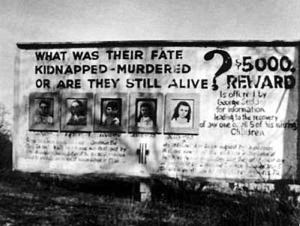 The billboard maintained by the Sodder family with pictures of the five children believed to be missing | |
| Date | December 24, 1945 |
|---|---|
| Duration | Missing for 78 years, 10 months and 30 days |
| Location | Fayetteville, West Virginia, U.S. |
| Type | Disappearance, house fire, possible arson, possible murder, possible kidnapping |
| Cause | Disputed |
| Motive | Possibly retaliation for George Sodder's statements against Fascist Italy[a] |
| Outcome | Cold case |
| Deaths | Death certificates issued by the state on December 30, 1945; findings disputed |
| Missing |
|
| Accused | Sicilian Mafia |
On Christmas Eve, December 24, 1945, a fire destroyed the Sodder residence in Fayetteville, West Virginia, United States. At the time, it was occupied by George Sodder, his wife Jennie, and nine of their ten children. During the fire, George, Jennie, and four of the nine children escaped. The bodies of the other five children have never been found. The surviving Sodder family believed for the rest of their lives that the five missing children survived.[1]
The Sodders never rebuilt the house, instead converting the site into a memorial garden to the lost children. In the 1950s, as they came to doubt that the children had perished, the family put up a billboard at the site along State Route 16 with pictures of the five, offering a reward for information that would bring closure to the case. It remained standing until shortly after Jennie Sodder's death in 1989.[2]
In support of their belief that the children survived, the Sodders had pointed to a number of unusual circumstances before and during the fire. George disputed the Fayetteville fire department's finding that the blaze was electrical in origin, noting that he had recently had the house rewired and inspected. George and his wife suspected arson, leading to theories that the children had been taken by the Sicilian Mafia, perhaps in retaliation for George's outspoken criticism of the fascist government of his native Italy.
State and federal efforts to investigate the case further in the early 1950s yielded no new information. The family did, however, later receive what may have been a picture of one of the boys as an adult during the 1960s. Their last surviving daughter, Sylvia, along with their grandchildren, continued to publicize the case in the 21st century in the media and online.[3]
Cite error: There are <ref group=lower-alpha> tags or {{efn}} templates on this page, but the references will not show without a {{reflist|group=lower-alpha}} template or {{notelist}} template (see the help page).
- ^ Abbott, Karen (December 25, 2012). "The Children Who Went Up In Smoke". Smithsonian. Retrieved December 2, 2015.
- ^ Horn, Stacy (December 23, 2005). "Mystery of Missing Children Haunts W.Va. Town". National Public Radio. Retrieved December 2, 2015.
- ^ "Sylvia Paxton". Charleston Gazette-Mail. Retrieved 2021-04-28.